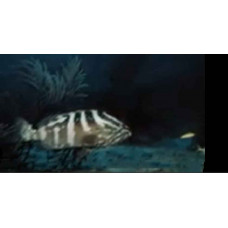Latin name
Epinephelus striatus
Other names
Hamlet; Creole: negue; French: mérou rayé; Spanish: cherna criolla, mero gallina.
Identification
The body is relatively tall. The coloration of the Nassau grouper varies; it usually has a light background, a broad dark brown stripe running from the tip of the snout through each eye to the beginning of the dorsal fin, and four or five irregular dark stripes running vertically along the sides. Two distinctive features are black dots, always present around the eyes, and a large black saddle on the caudal fin, also always present regardless of the color of the fish. The third spike of the dorsal fin is longer than the second, the pelvic fins are shorter than the pectoral fins, and the dorsal fin is serrated between the spikes. It has the capacity to change color, from pale to almost black. The scales are ctenoid, coarse, and go over the soft part of the vertical fins and upper jawbone.
Distribution
In the western Atlantic Ocean, Nassau grouper are found in Bermuda, Florida, the Bahamas, the Yucatán Peninsula, and throughout the Caribbean to southern Brazil. Absent in the Gulf of Mexico, except for Campeche Bay off the Yucatán coast, Tortugas, and Key West.
Habitat
Offshore coastal fish. Keeps solitary. Occurs in depths of 20 to 100 feet, although it almost always lives in depths less than 90 feet, Nassau grouper prefer caves and coral reefs in shallow and mid-water. Smaller fish tend to live closer to shore and are often found in seagrass beds; adults are usually further offshore on rocky reefs. Nassau grouper typically rest on the bottom, blending in with their surroundings. They are usually solitary and diurnal, but sometimes form shoals.
Size
The Nassau grouper is usually 1 to 2 feet in length, reaching a maximum of 4 feet and about 55 pounds, although most catches are under 10 pounds. The all-tackle world record is a 38-pound, 8-ounce Bahamian fish.
Life history and Behavior
Spawning around the new moon, Nassau grouper come together in large masses of up to 30,000, making them highly vulnerable to overharvesting.
Food and feeding habits
Predator. The Nassau grouper feeds mainly on fish and crabs and, to a lesser extent, on other crustaceans and mollusks.
Reproduction
No information
| Classification | |
| Phylum | Chordata |
| Class | Actinopterygii |
| Squad | Perciformes |
| Family | Serranidae |
| Genus | Epinephelus |
| Species | E. striatus |
| Features | |
| Conservation status | Critically Endangered |
| Habitat | Pelagic |
| Life span, years | No information |
| Maximum body weight, kg | 25 |
| Maximum length, cm | 122 |
| Sailing speed, m/s | No information |
| Threat to people | No information |
| Way of eating | Predator |



